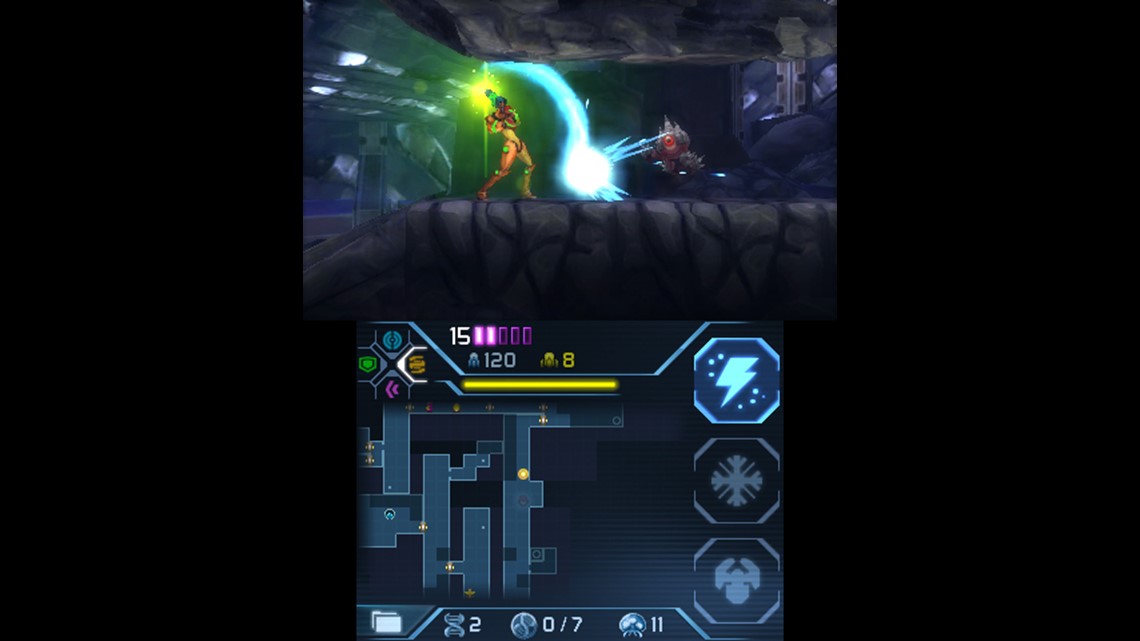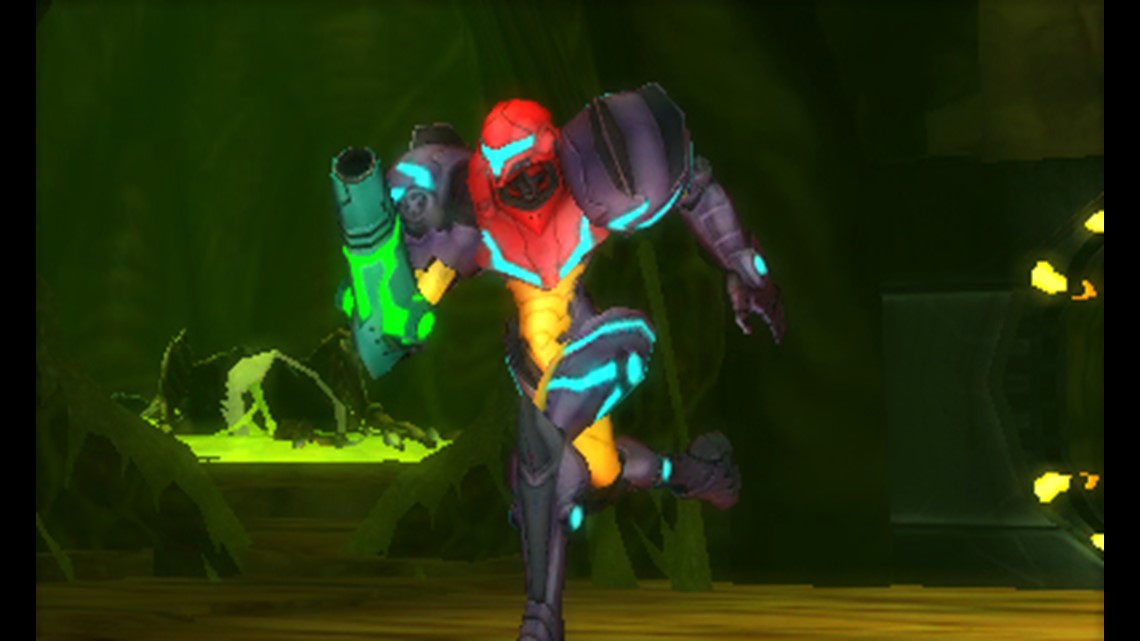

- Nintendo 3DS / rated E10+ / $39.99 / released September 2017
- OFFICIAL SITE: Nintendo.com
- PURCHASE LINK: Nintendo.com
- FINAL: You WANT this game. 4 out of 5 stars
On paper, “Metroid: Samus Returns” is a remake of a 1991 Game Boy game that has largely vanished down Nintendo’s memory hole. But when you play it, “Samus Returns” is much more than an old game made palatably prettier. It’s a full-on re-imagining, with added features and combat abilities that mesh together to form an undeniably modern “Metroid.”
As bounty hunter Samus Aran, you must explore the desolate planet SR388. Your mission is to exterminate the Metroids, a species of flying alien jellyfish whose voracious appetite is a threat to the entire galaxy. SR388 is a gigantic maze, with doors and barriers that will block your path until you find the one particular item or weapon that will let you pass through. This system of locks-and-keys drives the game, letting you freely criss-cross the planet’s caves in search of the keys in order to open all of the locks.
Naturally, the caves are crawling with other aggressive critters outside of the Metroids themselves (which are reserved for dramatic combat sequences.) The garden-variety slugs and bats introduce one of the new additions to “Samus Returns”: the melee counter. Many enemies will flash or blink just before charging you, creating a brief timing window for you to hit a button and slap the baddie down. Of course, you can still use Samus’ regular laser-firing arm cannon attack, but the melee counter interestingly changes up your rhythm and is quicker to dispatch enemies.


This “Metroid” is also much more concerned with keeping you from getting lost, compared to older games in the line. “Samus Returns” makes great use of teleporter pads and map icons to keep you oriented, plus the game adds a new scan pulse ability lets you check the surrounding area for any of the franchise’s famous hidden secrets. SR388 is peppered with path-revealing destructible blocks that, again, tie into the game’s lock-and-key system. You need to use particular weapons to destroy the blocks and open up secret areas that hold much-needed bonus power-ups.
Old school “Metroid” fans may balk at this built-in hint system, preferring to explore and discover surprises on their own… but there’s simply too many crumbling walls and stashed goods to locate, and the game is already backtrack-heavy by nature. Finding all (or most) of the upgrades will help in the many multi-stage battles where survival often comes down to endurance as well as video game reflexes.
Even if you use the scan pulse to seek out secrets, finding one is not the same as getting one. Many of the power-ups are at the center of little puzzles, where you must work out which of Samus’ abilities to leverage. For example, collecting a bonus missile item might require you to make your way around a fan that negates your bombs, or find a hidden grapple point to clear a range of impassable spikes. “Samus Returns” packs a good amount of thinking alongside all of the shooting.


“Samus Returns” features amiibo support to give players another way for a leg up (note that these figures are a separate purchase.) Scanning in Nintendo’s “Metroid” amiibo toys will give Samus some helpful last-ditch failsafes, like bonuses to her health meters and ammunition count.
You can judge for yourself how deeply you want to employ these self-help options, but you can’t miss how fast and fun it is to explore SR388. She starts out with a basic weapon and simple jump, but by the game’s halfway point Samus is much more powerful and nimble. Spinning jump attacks, sticky bombs, gravity-defying wall traversal, and elemental protection all become part of Samus’ skillset.
The worst bits of “Metroid: Samus Returns” are the overlong boss fights, where you are pitted against some incredibly powerful enemy. There’s just too many fake-outs, where you think the boss has been defeated, only for it to keep on fighting. Several of these battles make you complete the fight in one shot, so any unfortunate deaths on your part mean you must start the entire sequence over from the beginning.


“Samus Returns” provides a lovely visual update to the original game’s viewpoint. “Returns” retains the classic two-dimensional perspective, meaning that Samus only moves left-right and up-down, but the world is still 3-D (think: the depth as you look into the screen) and designed with plenty of atmospheric details. It looks fantastic, cramming plenty of different environments into the relatively small space (and low resolution) of the Nintendo 3DS.
Conversely, “Samus Returns” is very light on any kind of story, providing only the barest exposition at the adventure’s start and end. In a game that otherwise feels fully renovated, that’s the only part of “Metroid: Samus Returns” that still seems like it’s stuck in 1991.
“Metroid: Samus Returns” is available for Nintendo 3DS. This review is based on product supplied by the publisher. Images courtesy Nintendo of America.



